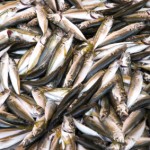I've been looking at three articles on which fish we should be eating. One came from a newspaper, one from a health.usnews.com website and the third from the Environmental Defense Fund website.
One of the dietary changes we've heard repeatedly over the last few years, besides eating more fruits and veggies and less red met, is to eat more fish. We're fortunate to have a wonderful restaurant here that's simply titled "Fish." We eat there fairly frequently, especially before attending plays (but that's another story). We also cook fish at home at least once and usually twice a week.
So which kind of fish should we be eating? That leads to the questions of sustainability, heart health and contaminants. To those, based on a recent experience, I'd add the risk of toxins (I'll write a blog post about that some other time).
The article from the Wall Street Journal (March 2, 2011) focused on salmon, talking about Wild Alaskan, Wild Pacific, Farmed Atlantic and Closed Tank-Framed varieties. The Farmed Atlantic salmon raised many enivronmental concerns and both Seafood Watch and Greenpeace decry salmon farming, stating it takes three pounds of wild-caught fish to produce one pound of salmon.
The Wild Alaskan salmon got kudos from Seafood Watch, although another group noted that 40% of "wild" salmon caught in the state's waters were actually raised in hatcheries. Wild Pacific slamon raised sustainability concerns from some groups, but not all.
Confusing, huh? Well then I turned to the online health.usnews.com piece. This had three distinct sections: the AHA wants us to consume more omega-3s and recommends mackerel, lake trout, herring, sardines, albacore tuna and salmon as good sources. Yet in the contaminant section it's noted that albacore tuna, high on the food chain, carry the risk of mercury and PCBs. There's debate as to the risk for most adults, but pregnant women (or those who are at risk of pregnancy) should clearly avoid this fish choice.
And farmed salmon, high up on the list of omega-3s, is tough to raise in a sustainable fashion.
The Environmental Defense Fund suggests we eat wild salmon from Alaska, pink shrimp from Oregon, talapia from the US, farmed rainbow trout, alabacore tuna from the US or Canada, yellowfin from the US. The EWG website led me to a Mark Bittman article (New York Times November 16, 2008) where Mark lauds wild-caught fish; he finds the flavor better and the environmental concerns lessened.
So what are we to do? I'd suggest eating more fish, trying to eat some fatty fish, eating less farmed fish and reading more about the issues involved. I may try more sardines.
The real question is whether there will be enough wild fish for all.

